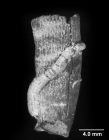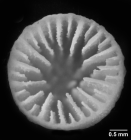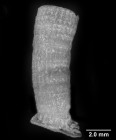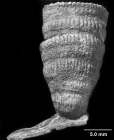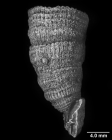WoRMS taxon details
Aulocyathus Marenzeller, 1904
135084 (urn:lsid:marinespecies.org:taxname:135084)
accepted
Genus
Aulocyathus juvenescens Marenzeller, 1904 (type by monotypy)
Fragilocyathus Yabe & Eguchi, 1932 · unaccepted > junior subjective synonym
- Species Aulocyathus atlanticus Zibrowius, 1980
- Species Aulocyathus juvenescens Marenzeller, 1904
- Species Aulocyathus matricidus (Saville Kent, 1871)
- Species Aulocyathus recidivus (Dennant, 1906)
- Species Aulocyathus conotrochoides (Yabe & Eguchi, 1932) accepted as Aulocyathus matricidus (Saville Kent, 1871) (unaccepted > junior subjective synonym)
marine, fresh, terrestrial
recent + fossil
Marenzeller, E. von. (1904). Steinkorallen. <em>Wissenschaflichte Ergebnisse der deutschen Tiefsee-Expedition auf dem Dampfer "Valdivia", 1838-1899,.</em> Band 7: 281-318, pls. 14-18., available online at https://www.biodiversitylibrary.org/page/6308054 [details]
Depth range 84-1716 m
Fossil range Pleistocene to Recent
Depth range 84-1716 m [details]
Fossil range Pleistocene to Recent
Fossil range Pleistocene to Recent [details]
Hoeksema, B. W.; Cairns, S. (2024). World List of Scleractinia. Aulocyathus Marenzeller, 1904. Accessed through: World Register of Marine Species at: https://www.marinespecies.org/aphia.php?p=taxdetails&id=135084 on 2024-04-16
Date
action
by
2006-09-06 06:55:51Z
changed
Martinez, Olga
![]() The webpage text is licensed under a Creative Commons Attribution 4.0 License
The webpage text is licensed under a Creative Commons Attribution 4.0 License
original description
Marenzeller, E. von. (1904). Steinkorallen. <em>Wissenschaflichte Ergebnisse der deutschen Tiefsee-Expedition auf dem Dampfer "Valdivia", 1838-1899,.</em> Band 7: 281-318, pls. 14-18., available online at https://www.biodiversitylibrary.org/page/6308054 [details]
original description (of Fragilocyathus Yabe & Eguchi, 1932) Yabe H, Eguchi M. (1932). A study of the recent deep-water coral fauna of Japan. <em>Proceedings of the Imperial Academy of Japan.</em> 8: 387-390. [details]
context source (Hexacorallia) Fautin, Daphne G. (2013). Hexacorallians of the World. (look up in IMIS) [details]
basis of record Cairns, S.D., Hoeksema, B.W., and J. van der Land, 2001. Scleractinia, <B><I>in</I></B>: Costello, M.J. <i>et al.</i> (Ed.) (2001). <i>European register of marine species: a check-list of the marine species in Europe and a bibliography of guides to their identification. Collection Patrimoines Naturels,</i> 50: pp. 109-110 (look up in IMIS) [details]
additional source Neave, Sheffield Airey. (1939-1996). Nomenclator Zoologicus vol. 1-10 Online. <em>[Online Nomenclator Zoologicus at Checklistbank. Ubio link has gone].</em> , available online at https://www.checklistbank.org/dataset/126539/about [details]
additional source Veron JEN. (1986). Corals of Australia and the Indo-Pacific. <em>Angus & Robertson Publishers.</em> [details]
additional source Squires, D. F. (1959). Deep sea corals collected by the Lamont Geological Observatory. 1 Atlantic corals. American Museum Novitates, 1965, 1-42
page(s): 23-24, figs. 11-12 [details]
additional source Cairns, S.D., R. Baron-Szabo, A.F. Budd, B. Lathuilière, E. Roniewicz, J. Stolarski & K.G. Johnson. (2010). Corallosphere. , available online at http://www.corallosphere.org [details]
additional source Yabe H, Eguchi M. (1942). Fossil and recent simple corals from Japan. <em>Science Reports Tohoku Imperial University, 2nd Series (Geology).</em> 22 (2): 105-178, pls. 9-12. [details]
redescription Cairns, S.D. (1995). The marine fauna of New Zealand: Scleractinia (Cnidaria: Anthozoa. <em>New Zealand Oceanographic Memoir.</em> 103: 1-210. [details] Available for editors [request]
[request]
original description (of Fragilocyathus Yabe & Eguchi, 1932) Yabe H, Eguchi M. (1932). A study of the recent deep-water coral fauna of Japan. <em>Proceedings of the Imperial Academy of Japan.</em> 8: 387-390. [details]
context source (Hexacorallia) Fautin, Daphne G. (2013). Hexacorallians of the World. (look up in IMIS) [details]
basis of record Cairns, S.D., Hoeksema, B.W., and J. van der Land, 2001. Scleractinia, <B><I>in</I></B>: Costello, M.J. <i>et al.</i> (Ed.) (2001). <i>European register of marine species: a check-list of the marine species in Europe and a bibliography of guides to their identification. Collection Patrimoines Naturels,</i> 50: pp. 109-110 (look up in IMIS) [details]
additional source Neave, Sheffield Airey. (1939-1996). Nomenclator Zoologicus vol. 1-10 Online. <em>[Online Nomenclator Zoologicus at Checklistbank. Ubio link has gone].</em> , available online at https://www.checklistbank.org/dataset/126539/about [details]
additional source Veron JEN. (1986). Corals of Australia and the Indo-Pacific. <em>Angus & Robertson Publishers.</em> [details]
additional source Squires, D. F. (1959). Deep sea corals collected by the Lamont Geological Observatory. 1 Atlantic corals. American Museum Novitates, 1965, 1-42
page(s): 23-24, figs. 11-12 [details]
additional source Cairns, S.D., R. Baron-Szabo, A.F. Budd, B. Lathuilière, E. Roniewicz, J. Stolarski & K.G. Johnson. (2010). Corallosphere. , available online at http://www.corallosphere.org [details]
additional source Yabe H, Eguchi M. (1942). Fossil and recent simple corals from Japan. <em>Science Reports Tohoku Imperial University, 2nd Series (Geology).</em> 22 (2): 105-178, pls. 9-12. [details]
redescription Cairns, S.D. (1995). The marine fauna of New Zealand: Scleractinia (Cnidaria: Anthozoa. <em>New Zealand Oceanographic Memoir.</em> 103: 1-210. [details] Available for editors
 Present
Present  Inaccurate
Inaccurate  Introduced: alien
Introduced: alien  Containing type locality
Containing type locality
From editor or global species database
Comparison Similar to Conotrochus, but having residual parent fragment attached to base. [details]Diagnosis Corallum solitary, ceratoid, free, most corolla showing evidence of budding from a longitudinal sector of a parent corallum; costae poorly defined; upper, outer edges of septa join theca below upper thecal edge, usually forming a circular trough around the calice; paliform lobes present; columella trabecular. [details]
Remark Four species, including one with a fossil record. [details]
From other sources
Biology azooxanthellate [details]Depth range 84-1716 m [details]
Fossil range Pleistocene to Recent [details]


